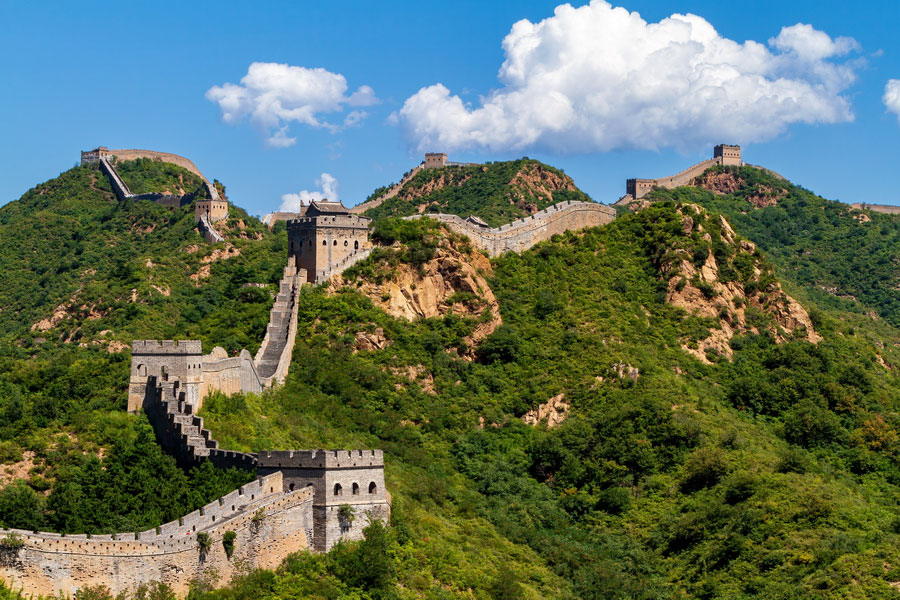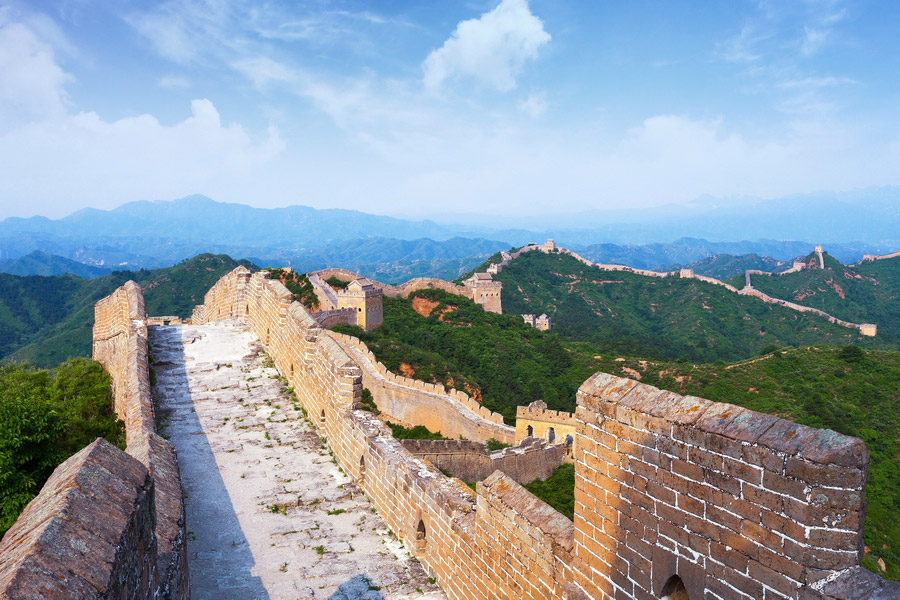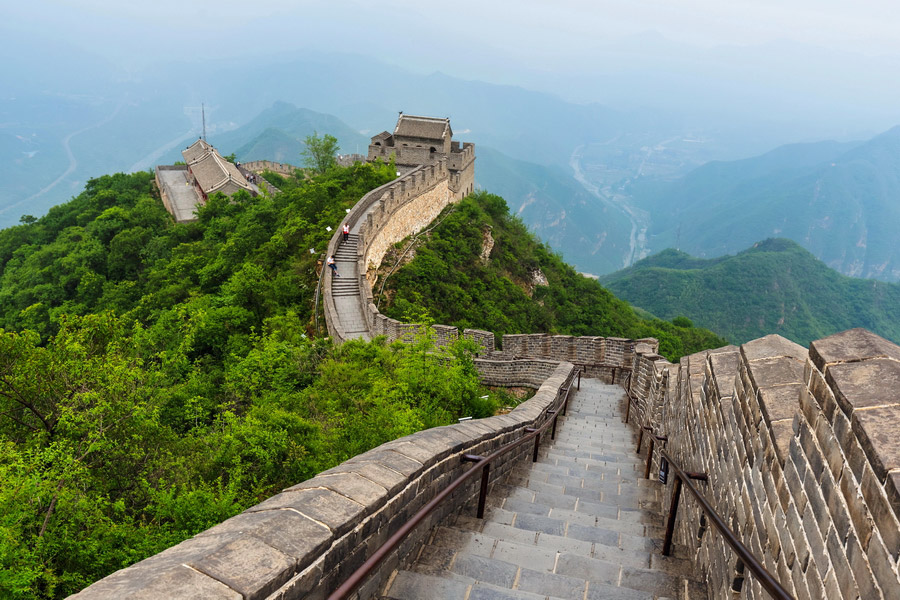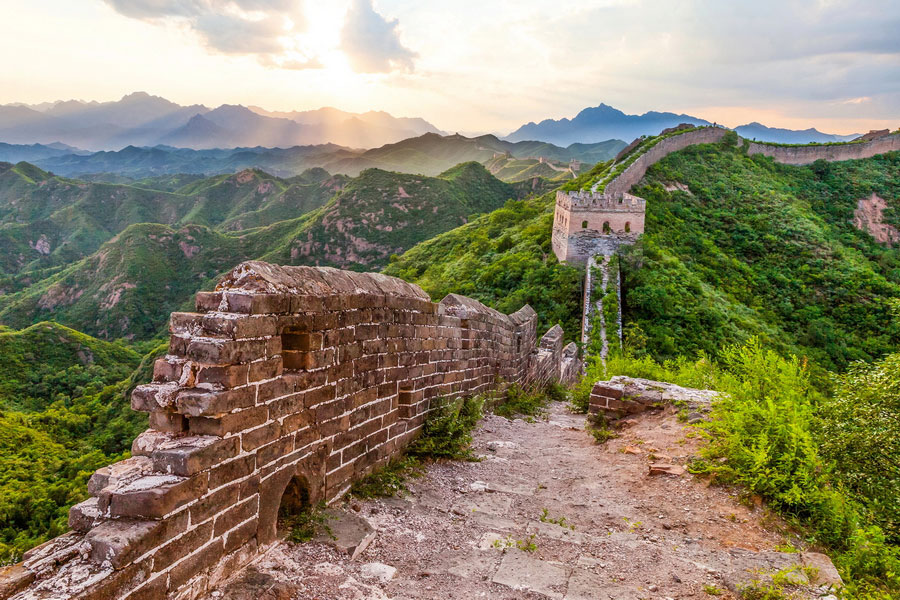
The Great Wall of China (长城) stretches from the country’s eastern coast to its western frontiers, crossing 15 regions in north China: Heilongjiang, Jilin, Liaoning, Inner Mongolia, Beijing, Tianjin, Hebei, Shandong, Henan, Shanxi, Shaanxi, Gansu, Ningxia, Qinghai, and Xinjiang. Spanning more than 21,000 kilometres, it stands as one of the most ambitious architectural feats in human history. Along its length, the wall traverses mountain ranges, forests, plains, rocky plateaus, semi-deserts, and deep gorges - terrain that demanded a wide range of engineering solutions. Builders adapted the design to each landscape, demonstrating both strategic flexibility and remarkable craftsmanship. This is not a single, continuous wall; rather, it is a complex network of defensive lines that have been reconstructed and redirected over time, influenced by the rulers in power and the threats they faced. In addition to the main wall, the structure includes watchtowers, fortified gates, signal towers, and garrison posts.
The wall, built for survival , ranges in width from 4 to 9 metres - wide enough in many areas for patrols and even cavalry to pass. Its height typically falls between 6 and 10 metres, depending on terrain and defence needs. Each block was set by hand. Materials used in construction varied by region and era, including rammed earth, stone, fired bricks, lime mortar with pebbles, and even reed stalks. During the Ming Dynasty (1368–1644), more durable materials and advanced techniques were introduced, which is why many of the best-preserved sections date from this period.
Watchtowers were placed every 100 to 200 metres and served multiple roles, including surveillance, signalling, and storage. Signal towers enabled long-distance communication via smoke or fire warning Beijing in hours , while entry gates helped regulate the movement of people and goods along the border and imposed taxes on them. This highly integrated defensive network, which housed troops, not only helped repel invasions but also facilitated trade and safeguarded remote frontier regions, while making the statement that this land was governed.
Transcending its function as a mere wall, it emerged as an enduring symbol of China's strength, unity, and remarkable engineering knowledge.
The Organisation, Techniques, and Workforce Behind the Construction of the Great Wall

The construction of the Great Wall of China represented an extraordinary endeavour that relied on a vast and diverse labour force, comprising soldiers, peasants, prisoners, and conscripted workers. Throughout various dynasties, the scale and composition of this workforce evolved, yet the challenges they faced remained constant. Labourers endured arduous conditions, contending with extreme weather, traversing treacherous terrain, and managing limited resources. Many participated in the Wall's construction as part of their military duties or due to governmental mandates.
The organisation of this monumental undertaking was crucial to its success. Military commanders and engineers meticulously planned the layout and design of the Wall, ensuring that construction proceeded with both efficiency and effectiveness. Logistics played an indispensable role, as the transportation of materials to remote sites presented significant challenges. Workers frequently carried stones and earth over considerable distances, and human chains were established to facilitate the movement of resources. Furthermore, animals such as horses and oxen were employed to assist in the conveyance of heavy materials, thereby enhancing the construction process. This remarkable collaboration of human and animal effort culminated in one of history's most iconic structures, epitomising the determination and ingenuity of those who brought it to fruition.
Exploring the Architecture of the Most Famous Sections of the Great Wall
Badaling

On the Advantour 10-day Central China Essential Tour or the 12-day Central China Classic Tour, you will have the opportunity to experience the remarkable Badaling section. The section of the Great Wall in the Badaling area (about 70 km from Beijing) is built from massive granite blocks enclosing a compacted core of earth and gravel. A brick-paved road runs along the top - flat and wide enough to allow ten infantrymen or five horsemen to pass side by side - underscoring its strategic value for troop movements.
The upper part of the wall features crenellated parapets that acted as protective barriers. The gaps between the merlons provided openings for surveillance and targeted fire. Two-story watchtowers appear at intervals of roughly 400 meters. The upper level offered a commanding view and advantageous firing position, while the lower level - distinguished by vaulted ceilings - was used to store ammunition and provide rest space for guards. Signal towers lined the wall, creating an effective early-warning network through the use of fire or smoke signals.
Mutianyu

You can visit the Mutianyu section of the Great Wall by booking the 8-day China Small Group Tour with Advantour. The Mutianyu section of the Great Wall is known for its distinctive defensive architecture. Each crenel is fitted with a square embrasure, narrowed to improve the accuracy of fire. Uniquely, Mutianyu features loopholes not only on the outer side of the wall but also on the inner side, allowing defenders to respond to surprise attacks from the rear. To further reinforce the defence, additional parallel walls and observation towers were constructed in front of the main fortification, serving to slow down enemy advances before they reached the core defensive line.
The wall at Mutianyu is also notable for how seamlessly it blends into the mountainous terrain - winding with the natural contours, climbing steep slopes, and dropping sharply into valleys. One particularly striking segment scales an almost vertical cliff at an angle close to 90 degrees, a dramatic feat of engineering. In the Zhengguantai area, three watchtowers are built on a single terrace - an extremely rare configuration found along the entire length of the Great Wall.
From Beijing, Juyongguan (60 kilometres), Huanghuacheng and Jiankou (70 kilometres), Simatai (120 kilometres), Gubeikou (140 kilometres) and Shanhaiguan (300 kilometres) are other famous sections of the Great Wall that can be visited.
Defensive and Strategic Features of the Great Wall
- The wall served not only as a barrier against nomadic invasions but also as a strategic corridor for rapidly moving troops between different regions of the country.
- In hard-to-reach areas such as the Yanshan Mountains, it was constructed in a zigzag pattern to improve visibility and strengthen defensive positions.
- During the Ming Dynasty, specialised artillery platforms were added to accommodate the use of cannons, reflecting advancements in military engineering.
- The China Silk Road did cross the Great Wall of China in several sections.
- Ramparts and battlements feature walkable surfaces equipped with defensive notches designed for archers and patrolling soldiers.
- Watchtowers were positioned every few hundred meters, allowing soldiers to survey the area for approaching enemies, fire arrows, and seek refuge during storms.
- Signal beacons utilized fire and smoke to convey coded messages between towers, with a single spark capable of indicating a border breach hundreds of miles away.
- Garrison stations served as accommodations for troops, weapons, and supplies, forming an integrated defence network that was prepared to respond swiftly.
Preservation

Today, only about 30% of the Great Wall remains in good condition - primarily the Ming-era sections near Beijing. Much of the rest has been heavily damaged over time or by human activity; for instance, during the 20th century, stones and bricks were often removed for use in local construction. However, the Chinese government, along with international organisations such as UNESCO, continues to monitor the wall’s condition and restore deteriorated sections to preserve this iconic monument for future generations.
Architectural Details of the Great Wall: Bricks, Towers, and Inscriptions
For those with a passion for architecture and history, embarking on a quest to uncover the hidden treasures of the Great Wall promises an enriching experience.
- Begin your treasure hunt by seeking out stones adorned with the builder marks or military insignia. Some bricks may bear date stamps that reveal their period of manufacture, assisting in the identification of the construction era.
- As you explore the various sections, keep an eye out for carvings or inscriptions that hold cultural or historical significance, each adding a unique chapter to the wall's storied narrative.
- Observe the diverse materials used in the wall's construction: bricks dominate the eastern regions, while rammed earth is more commonly found in the west. Compare the variations in shapes and colours, each telling its own tale.
- The watchtower at the Mutianyu section is notably larger than its counterparts. Typically, watchtowers are square or rectangular in form and may feature multiple levels.
- The domes of the watchtowers are an uncommon feature along the Great Wall. Each dome is flanked by four door openings, aligned with the cardinal directions of East, West, South, and North.
- The roofs of the watchtowers may exhibit distinctive architectural styles, frequently characterised by traditional Chinese eaves that gracefully curve upwards.

